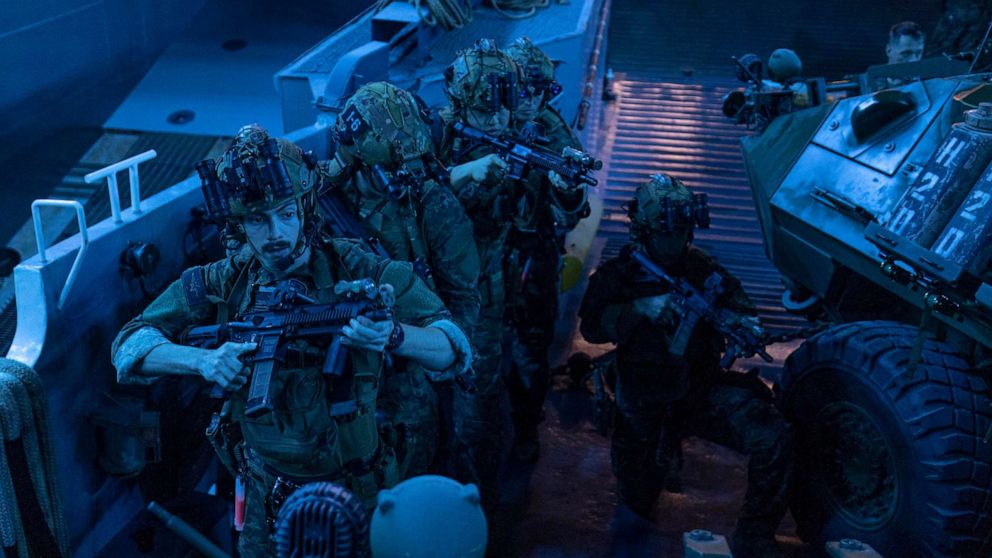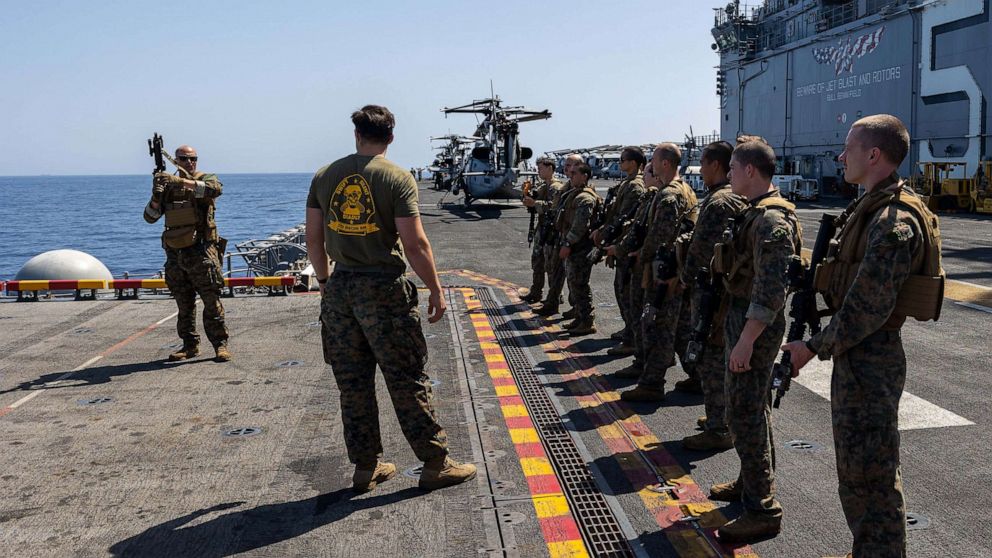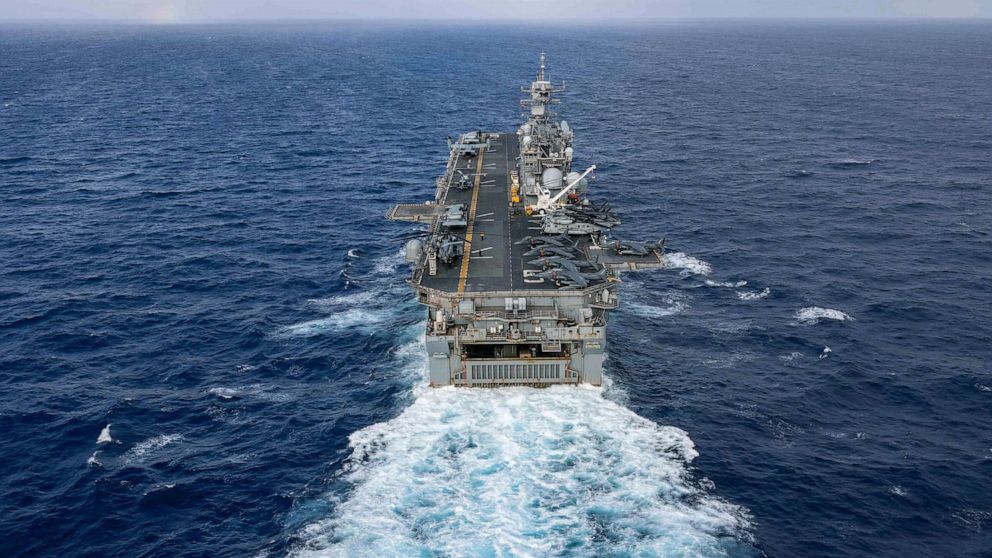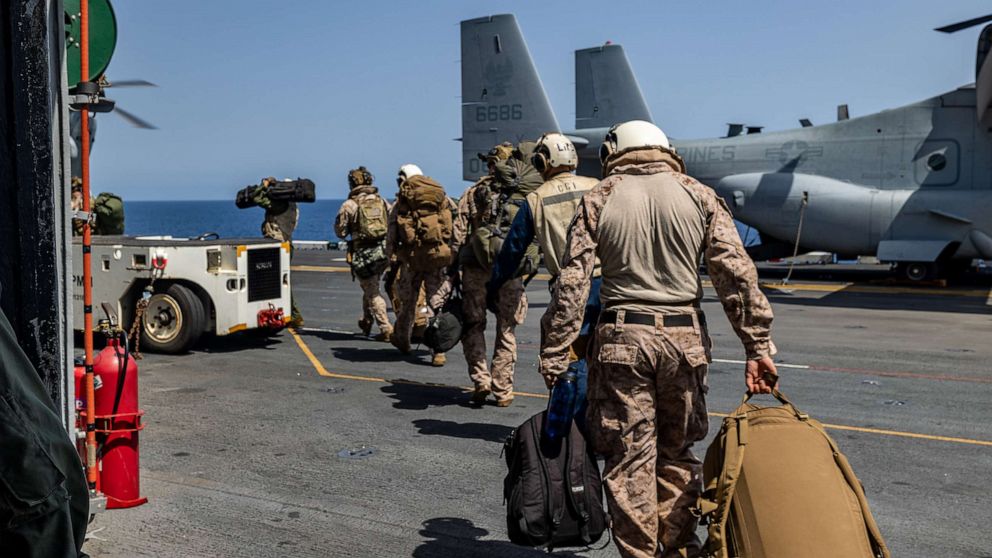Watch CBS News
Be the first to know
Get browser notifications for breaking news, live events, and exclusive reporting.
Watch CBS News
Be the first to know
Get browser notifications for breaking news, live events, and exclusive reporting.
Beirut — The Syrian army said Friday that Israeli airstrikes near the northern city of Aleppo had killed or wounded “a number of” people and caused damage. A war monitoring group said the strikes killed 44 people, most of them Syrian troops.
The U.K.-based Syrian Observatory for Human Rights, an opposition war monitor group, said Israeli strikes hit missile depots belonging to Lebanon’s militant Hezbollah group in Aleppo’s southern suburb of Jibreen, near the Aleppo International Airport, and the nearby town of Safira, home to a sprawling military facility.
The observatory said 36 Syrian troops, seven Hezbollah fighters and a Syrian member of an Iran-backed group died and dozens of people were wounded, calling it the deadliest such attack in years.
There was no immediate statement from Israeli officials on the strikes specifically, but Defense Minister Yoav Gallant was quoted by the Times of Israel’s defense correspondent as saying hours after that the military would be expanding its ongoing campaign against the powerful Iran-allied group, and that Israel was “turning from defending to pursuing Hezbollah.”
“We will reach wherever the organization operates, in Beirut, Damascus and in more distant places,” Gallant said, according to Times reporter Emanuel Fabian.
Israel, which has vowed to stop Iranian entrenchment in its northern neighbor, has carried out hundreds of strikes on targets in government-controlled parts of Syria in recent years, but it rarely acknowledges them.
On Thursday, Syrian state media reported airstrikes near the capital, Damascus, saying they wounded two civilians.
Hezbollah has had an armed presence in Syria since it joined the country’s civil conflict more than a decade ago, fighting alongside government forces.
Aleppo, Syria’s largest city and once its commercial center, has come under such attacks in the past that led to the closure of its international airport. Friday’s strike did not affect the airport.
The strikes have escalated over the past five months against the backdrop of the war in Gaza and ongoing clashes between Hezbollah and Israeli forces on the Lebanon-Israel border.
Hezbollah is an ally of Gaza’s Hamas rulers, who sparked the current war with their bloody Oct. 7 terrorist attack on Israel. Both groups are considered part of the network of armed proxy forces backed by Iran across the Middle East.
In neighboring Lebanon, an Israeli drone strike hit a car near the southern port city of Tyre and killed a Hezbollah member, Lebanese state media reported. Israel’s military said the targeted man was Ali Naim, the deputy head of Hezbollah’s rocket and missile program. The group confirmed he was killed, without stating what his job was within the organization.
The drone strike that killed Naim came a day after Hezbollah fired rockets with heavy warheads at towns in northern Israel, saying it used the weapons against civilian targets for the first time in retaliation for Israeli airstrikes the night before that killed nine people, including what the group said were several paramedics.
Since the outbreak of the Israel-Hamas war in Gaza, concerns have grown that near-daily clashes along the border between Israel and Lebanon could escalate into a full-scale war, which could draw in other countries including Iran.
DUBAI (Reuters) – Iran has obtained the technology to build a supersonic cruise missile which is still under test, the semi-official Tasnim news agency reported on Wednesday.
The announcement comes amid rising tensions with the U.S. in the Gulf and following the unveiling last week of new vessels equipped with 600-km range missiles.
“This missile, which is a new generation of Iranian-made cruise missiles, is currently undergoing its tests and will be a new chapter in Iran’s defence power,” the agency said.
(Reporting by Elwely Elwelly; Editing by Toby Chopra)
(Reuters) – Russia on Tuesday aligned itself with its ally Iran in rejecting Western attempts to maintain curbs on Iran despite the collapse of a 2015 deal intended to restrain Tehran’s nuclear program in return for relief from sanctions.
After a meeting between respective deputy foreign ministers in Tehran, Russia’s foreign ministry said Moscow and Tehran were unanimous in believing that the failure to implement the deal stemmed from the “erroneous policy of ‘maximum pressure’ pursued by the United States and those who think similarly”.
Then-U.S. president Donald Trump quit the deal known as the JCPOA in 2018, leaving economic sanctions in place, and Iran’s relations with the West have been deteriorating ever since, as it has accelerated its nuclear programme.
But Russia, which signed the deal alongside the U.S., China, Britain, France, Germany and the European Union, has been deepening ties with Iran since its invasion of Ukraine.
The war, which Russia calls a “special military operation”, has driven its own relations with the West to their lowest level in decades.
Sources told Reuters in June that European diplomats had informed Iran they planned to join the U.S. in retaining sanctions on Iran’s ballistic missile programme that are set to expire in October under the nuclear deal.
They gave three reasons: Russia’s use of Iranian drones against Ukraine; the possibility that Iran might transfer ballistic missiles to Russia; and depriving Iran of the benefits of the nuclear deal, which it violated after the U.S. withdrew.
Russian Deputy Foreign Minister Sergei Ryabkov met Iranian counterparts Ali Bagheri Kani and Reza Najafi.
Russia’s foreign ministry said the meeting had emphasised “the unacceptability of any attempts on the part of the West to impose some new schemes and approaches to solving problems related to the JCPOA, which imply damage to legitimate and mutually beneficial Russian-Iranian cooperation in various fields”.
It said there was still “no reasonable alternative” to implementing the JCPOA, as approved by the U.N. Security Council.
(Reporting by Reuters; Writing by Kevin Liffey; editing by Jonathan Oatis)

More than 3,000 US military personnel have arrived in the Red Sea aboard two warships, as part of increased deployments after tanker seizures by Iran, the US Navy said Monday.
The US sailors and Marines entered the Red Sea on Sunday after transiting through the Suez Canal in a pre-announced deployment, the US Navy’s Fifth Fleet said in a statement.
They arrived on board the USS Bataan and USS Carter Hall warships, providing “greater flexibility and maritime capability” to the Fifth Fleet, the statement added.
The US military says Iran has either seized or attempted to take control of nearly 20 internationally flagged ships in the region over the past two years.
USS Bataan is an amphibious assault ship which can carry fixed-wing and rotary aircraft as well as landing craft. The USS Carter Hall, a dock landing ship, transports Marines, their gear, and lands them ashore.
“These units add significant operational flexibility and capability as we work… to deter destabilising activity and deescalate regional tensions caused by Iran’s harassment and seizures of merchant vessels,” Fifth Fleet spokesman Commander Tim Hawkins told AFP.
The deployment comes after Washington said its forces blocked two attempts by Iran to seize commercial tankers in international waters off Oman on July 5.
The maritime services in Iran said one of the two tankers, the Bahamian-flagged Richmond Voyager, had collided with an Iranian vessel, seriously injuring five crew members, according to state news agency IRNA.
In April and early May, Iran seized two oil tankers within a week in regional waters.
Those incidents came after Israel and the United States blamed Iran in November for what they said was a drone strike against a tanker operated by an Israeli-owned firm carrying gas oil off the coast of Oman.
The US announced last month that it would deploy a destroyer, F-35 and F-16 warplanes, along with the Amphibious Readiness Group/Marine Expeditionary Unit, to the Middle East to deter Iran from seizing ships in the Gulf.
Last week, a US official told AFP that Washington is also preparing to deploy Marines and Navy personnel aboard commercial tankers transiting the Gulf as an added layer of defence.
bur/ho/it

Five people including two policemen were killed and at least 11 others injured during the collapse of several buildings in Iran’s capital, local media reported on Monday.
The policemen were securing the planned demolition on Sunday of “unauthorised buildings” in Tehran’s southwest, ISNA news agency said. Another news agency, Tasnim, said two of the officers were killed.
The overall “toll from the collapse” has reached five, spokesman for Tehran’s fire department, Jalal Maleki, told Fars news agency.
According to ISNA, authorities had begun the demolition of one building when five others collapsed.
Rescue operations were underway to find others who may be trapped under the rubble, ISNA and Tasnim reported.
Photographs from the scene issued by Tasnim showed rescuers and heavy equipment working below a pile of debris and twisted metal several metres (yards) high, with other unfinished and partially damaged buildings around them.
ISNA quoted a police statement saying the buildings which collapsed did not comply “with construction safety measures”.
A Tehran city official said on Saturday that authorities had demolished more than 46,000 unauthorised buildings over the past two years, according to Hamshahri newspaper.
In May 2022, a building collapse in Iran’s southwest killed 43 people, in one the country’s deadliest such incidents.
The collapse of the 10-storey Metropol building, which had been under construction in the city of Abadan in Khuzestan province, sparked protests across the country decrying corruption and incompetent authorities.
ap-rkh/mz/it
Thousands of sailors and Marines assigned to the Bataan Amphibious Ready Group and the 26th Marine Expeditionary Unit are operating in the Red Sea after transiting the Suez Canal, according to the U.S. 5th Fleet.
The announcement comes days after The Associated Press reported the military is contemplating placing armed personnel on commercial ships transiting through the Strait of Hormuz, in response to Iran seizing and harassing civilian vessels in the region.
The Associated Press reported that no final decisions were made on the matter, and officials said the Marines and Navy sailors would provide the security only at the request of the ships involved.
Cmdr. Timothy Hawkins, a spokesman for the U.S. 5th Fleet, declined to confirm to Navy Times whether the deployment was connected to reports of arming personnel on commercial ships. However, he said that the ships’ presence aims to “deescalate regional tensions caused by Iran’s harassment and seizures of merchant vessels earlier this year.”
The amphibious assault ship Bataan and dock landing ship Carter Hall got underway with more than 3,000 sailors and Marines from Norfolk, Va., last month. The Pentagon said the deployment was in response to Iran’s recent attempts to “threaten the free flow of commerce in the Strait of Hormuz and its surrounding waters.”
Navy: Iran tried to seize 2 oil tankers in Gulf, fired shots at one
“Bataan ARG/26th MEU units bring to the region additional aviation and naval assets, as well as more U.S. Marines and Sailors, providing greater flexibility and maritime capability to U.S. 5th Fleet,” the Navy said in a statement Monday.
The Bataan and Carter Hall join assets including Air Force F-35 and F-16 fighter jets, and the destroyer Thomas Hudner, sent to the Middle East last month to thwart Iran’s actions.
Those assets were deployed after Iran tried to seize two oil tankers in the Strait of Hormuz and the Gulf of Oman on July 5, according to Deputy Pentagon Press Secretary Sabrina Singh. The U.S. Navy destroyer McFaul intervened in both instances, prompting the Iranian vessels to depart the scene.
“One attempt included an Iranian navy ship firing upon the merchant vessel,” Singh said during a press briefing last month. “In light of this continued threat and in coordination with our partners and allies, the department is increasing our presence and ability to monitor the strait and surrounding waters.”
In total, U.S. Central Command claims that Iran has attacked or seized approximately 20 vessels since 2021.
“We call upon Iran to immediately cease these destabilizing actions that threaten the free flow of commerce through this strategic waterway, of which the world depends on for more than 1/5 of the world’s oil supply,” Singh said last month.
The Associated Press contributed to this report.
More than 3,000 Marines and sailors arrived in the Middle East on Sunday in a deployment meant to deter Iran from seizing and harassing merchant ships near the Strait of Hormuz, according to U.S. Naval Forces Central Command.
They came aboard the dock landing ship USS Carter Hall and amphibious assault ship USS Bataan, which together can carry dozens of aircraft, including Ospreys and Harrier jets, plus amphibious landing craft and tactical vehicles.

U.S. Marines with the 26th Marine Expeditionary Unit (Special Operations Capable)’s (MEU(SOC)) Maritime Special Purpose Force clear an Landing Craft Utility during training aboard the Wasp-class amphibious assault ship USS Bataan (LHD 5), Mediterranean Sea, July 31, 2023.
U.S. Marine Corps by Sgt. Matthew Romonoyske-Bean
These forces belong to the Bataan Amphibious Ready Group and 26th Marine Expeditionary Unit (MEU). The North Carolina-based MEU “is capable of conducting amphibious missions, crisis response and limited contingency operations to include enabling the introduction of follow-on forces and designated special operations,” according to a release from Naval Forces Central Command.
Defense Secretary Lloyd Austin ordered the move last month “in response to recent attempts by Iran to seize commercial ships” in the Middle East, according to U.S. Central Command.

Maritime Special Purpose Force Marines, assigned to the 26th Marine Expeditionary Unit Special Operations Capable, conduct weapons familiarization drills on the flight deck of the USS Bataan in the Mediterranean Sea, July 26, 2023.
U.S. Navy
Iran attempted to seize two commercial oil tankers in the Gulf of Oman in July, opening fire on one of them, according to the Navy. In May, the U.S. said, Iran seized two merchant ships within one week.
“Since 2021, Iran has harassed, attacked or seized nearly 20 internationally flagged merchant vessels, presenting a clear threat to regional maritime security and the global economy,” a Navy release stated in July.

The USS Bataan conducts routine operations in the Atlantic Ocean, July 20, 2023.
U.S. Navy
Some Marines of the 26th MEU were flown ahead for training in Bahrain in anticipation of being placed aboard commercial ships traveling through the Strait of Hormuz to stop Iran from capturing them, a U.S. official told ABC News on Friday.
The U.S. is considering multiple options and is likely to offer protections to ships that are U.S.-flagged, carrying crews that include U.S. citizens or bringing cargo to or from the U.S., according to the official. The commercial shipping industry has been made aware that this option is or will become available on a voluntary basis.
The U.S. now is waiting for commercial shipping companies to request protection. A senior White House official told ABC News last week that while the plan will likely be approved, no final authorization has been given to U.S. Central Command to go forward.
Pentagon press secretary Brig. Gen. Pat Ryder did not confirm the possibility when asked during a press gaggle on Monday.
“I’m aware of the press reports speculating that that’s something we may be looking at doing, but … I don’t have anything to announce,” Ryder said.

U.S. Marines with the 26th Marine Expeditionary Unit Maritime Special Purpose Force, prepare to depart the USS Bataan in the Mediterranean Sea, July 28, 2023.
U.S. Marine Corps
The ships and troops that arrived this weekend join other U.S. military support recently sent to the area.
“In response to a number of recent alarming events in the Strait of Hormuz, the secretary of defense has ordered the deployment of the destroyer USS Thomas Hudner, F-35 fighters and F-16 fighters to the U.S. Central Command area of responsibility to defend U.S. interests and safeguard freedom of navigation in the region,” Pentagon deputy press secretary Sabrina Singh said during a July 17 briefing.
More than 3,000 U.S. sailors and Marines reached the Red Sea on Sunday aboard the assault ship USS Bataan in response to Iran’s “harassment and seizures of merchant vessels,” according to the U.S. Naval Central Forces Central Command.
“These units add significant operational flexibility and capability as we work alongside international partners to deter destabilizing activity and deescalate regional tensions caused by Iran’s harassment and seizures of merchant vessels earlier this year,” the U.S. Fifth Fleet spokesman Cmdr. Tim Hawkins said in a statement shared with The Hill.
The arrival is part of a preannounced military deployment, the U.S. Naval Central Forces Command said. Hawkins said it signals the country’s “strong, unwavering commitment to regional maritime security.”
The assault ship arrived Sunday after traveling from the Mediterranean Sea through the Suez Canal. The U.S. Naval Central Forces Central Command said the USS Bataan and dock landing ship USS Carter Hall bring “additional aviation and naval assets, as well as more U.S. Marines and Sailors, providing greater flexibility and maritime capability to the U.S. 5th Fleet.”
The U.S. Naval Central Forces Central Command also said the assault ship can carry more than two dozen rotary-wing and fixed-wing aircraft and “several ambitious landing craft.” The dock landing ship will be used in operations for multiple rotary-wing aircraft, tactical vehicles and amphibious landing craft.
Since 2019, Iran has seized several ships in the strait, the narrow mouth of the Persian Gulf in an attempt to pressure the West over negotiations over its collapsed nuclear deal with world powers. Tensions have continued to rise since the Trump administration withdrew from Iran’s 2015 nuclear agreement and reinstated sanctions, according to The Associated Press.
The Associated Press contributed.
Copyright 2023 Nexstar Media Inc. All rights reserved. This material may not be published, broadcast, rewritten, or redistributed.
The company has denied that the seminar took place.
Activists say the cameras are being used at busy junctions to watch over women who remove their headscarves in public – a punishable offence under Iranian religious law.
Amnesty International has reported that women in Tehran are sent text messages by state security shortly after driving through junctions threatening them with fines for allegedly not wearing the headscarves properly.
Bosch has stated that the cameras it sold to Iran could be used for “intelligent tracking”, an AI-based technology that allows users to configure the camera to track vehicles or movements.
The company denies that the cameras were equipped with facial recognition technology but said there was nothing to prevent the Iranian state from using software from another firm to track facial images taken from their cameras.
Activists say that the cameras are being used by police to detect when small groups of people start to gather in a single location so that officers can swiftly end protests.
After a pact to control Iran’s nuclear ambitions in 2015 in exchange for an easing of sanctions, Berlin was the first western capital to improve business ties with Iran when the economy minister Sigmar Gabriel flew to the country with 150 business executives.
But German firms pulled out only two years later when the US withdrew from the nuclear treaty and threatened to impose sanctions on companies that continued to do business with Tehran.
Bosch said in a statement: “Bosch was not involved in the traffic monitoring project – nor were we aware of the use of our cameras in the project. In Iran, as in many other countries, Bosch has not directly sold its cameras to system integrators, facilities, or end customers.”